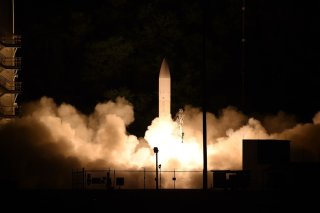The U.S. Army and Navy Teamed Up for a Ground-Breaking Hypersonic Test Flight
While both the Army and Navy weapons will use the same glide body, the services are each tailoring their respective launchers and weapons systems.
The Army and Navy together conducted a ground-breaking hypersonics flight “shot” test of the Common Hypersonic Glide Body (CHGB) planned to arm the Navy’s Conventional Prompt Strike weapon and the Army’s emerging Long-Range Hypersonic Weapon.
Called a “flight campaign,” the test was conducted by Sandia National Laboratories as part of an accelerated effort to mature, refine and fast-track a new generation of hypersonic weapons to operational status.
“This test demonstrated advanced hypersonic technologies, capabilities, and prototype systems in a realistic operating environment,” a Navy press statement said.
The CHGB is now being developed through a deal between the U.S. Army Hypersonic Project Office, Dynetics Technical Solutions, and General Atomics Electromagnetic Systems. Dynetics, operating with technological, electrical, and manufacturing support from General Atomics Electromagnetic Systems (GA-EMS), is now producing twenty prototype glide bodies.
“Our all-up round (CHGB) is a 34-inch booster which will be common between the Army and the Navy. We will shoot exactly the same thing the Navy shoots out of a sub or ship,” Robert Strider, Deputy at the Army Hypersonic Project Office, told an audience on August 11 at the Space and Missile Defense Symposium in Huntsville, Alabama.
The glide body is a warhead that gets thrust into the atmosphere at hypersonic speeds, traveling five or more times the speed of sound. Once airborne, the weapon can skip along the upper boundaries of the earth’s atmosphere before relying upon the sheer speed of its descent onto a target. Destruction of a target can be accomplished by the sheer force and speed of impact.
“We bring expertise in manufacturing highly complex systems, a long-standing relationship with Sandia National Laboratories, and prior experience on the Block 0 glide body, to this high priority national security program,” Scott Forney, president of GA-EMS, said in a company statement.
While many of the technological specifics of the glide body are not likely to be available for security reasons, the warhead is likely being engineered by GA-EMS for maximum penetration capability as well as precision guidance, high-speed flight, and durability. Building a resilient glide body sufficiently hardened against attempted enemy intrusions or defensive tactics is also likely to be an important goal.
The Navy statement on the test offered little detail but did say the services were pursuing an ambitious testing schedule to ensure hypersonic weapons are accelerated with a sense of urgency.
“During weapon system development, precision sounding rocket launches fill a critical gap between ground testing and full system flight testing. These launches allow for frequent and regular flight testing opportunities to support rapid maturation of offensive and defensive hypersonic technologies,” the Navy statement said.
While both the Army and Navy weapons will use the same glide body, the services are each tailoring their respective launchers and weapons systems, the Navy statement reported.
The principal tactical advantages of a hypersonic weapon are not only related to speed to impact and in-flight maneuverability but the tremendous challenge they present to enemy ground and space-based sensors and radar detection systems. An interesting October 2021 Congressional Research Service (CRS) Report on Hypersonic Weapons explains that the speed and parabolic trajectory of a ballistic missile make it possible for ground-based radar to track its approach during the earlier phases of its flight. Hypersonic weapons, however, are much more difficult to track as they travel from one radar “field of regard” or aperture to another so quickly that it can become nearly impossible to establish any kind of a “continuous track.” Also, the CRS report explains that if the weapons are detected at all, it will not be until the later or end-portions of its trajectory, a circumstance which naturally offers defending forces little or no time to respond or counterattack.
Kris Osborn is the defense editor for the National Interest. Osborn previously served at the Pentagon as a Highly Qualified Expert with the Office of the Assistant Secretary of the Army—Acquisition, Logistics & Technology. Osborn has also worked as an anchor and on-air military specialist at national TV networks. He has appeared as a guest military expert on Fox News, MSNBC, The Military Channel, and The History Channel. He also has a Master’s Degree in Comparative Literature from Columbia University.
Image: Wikimedia Commons

